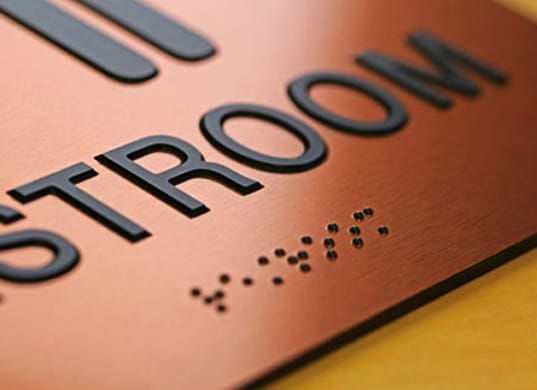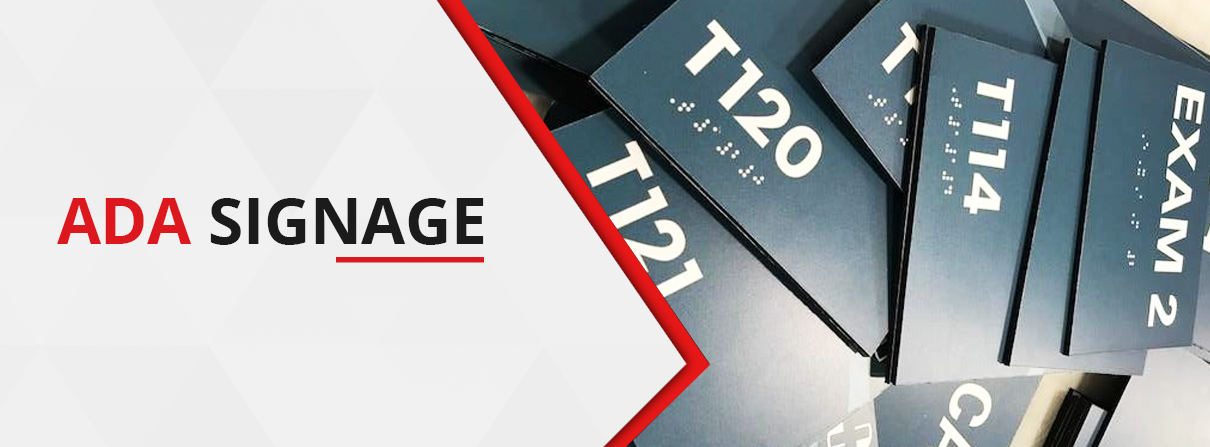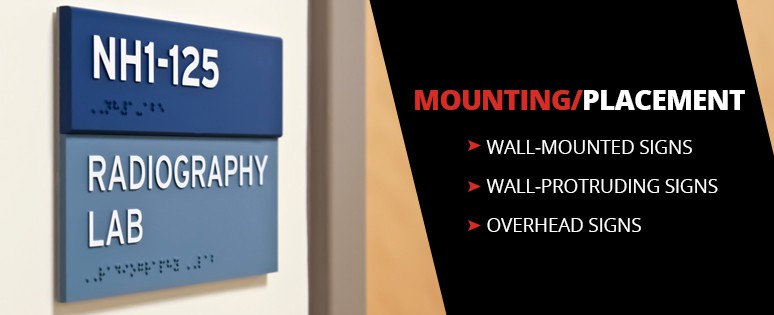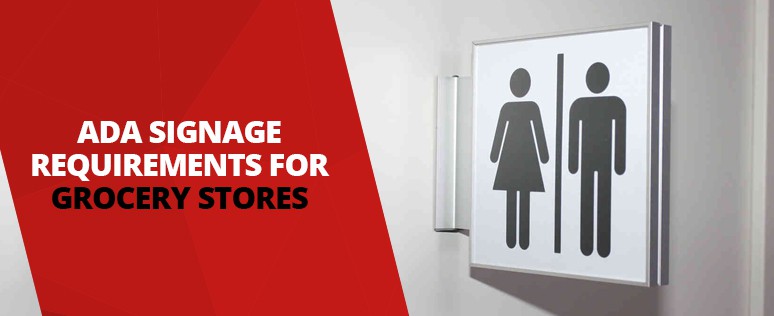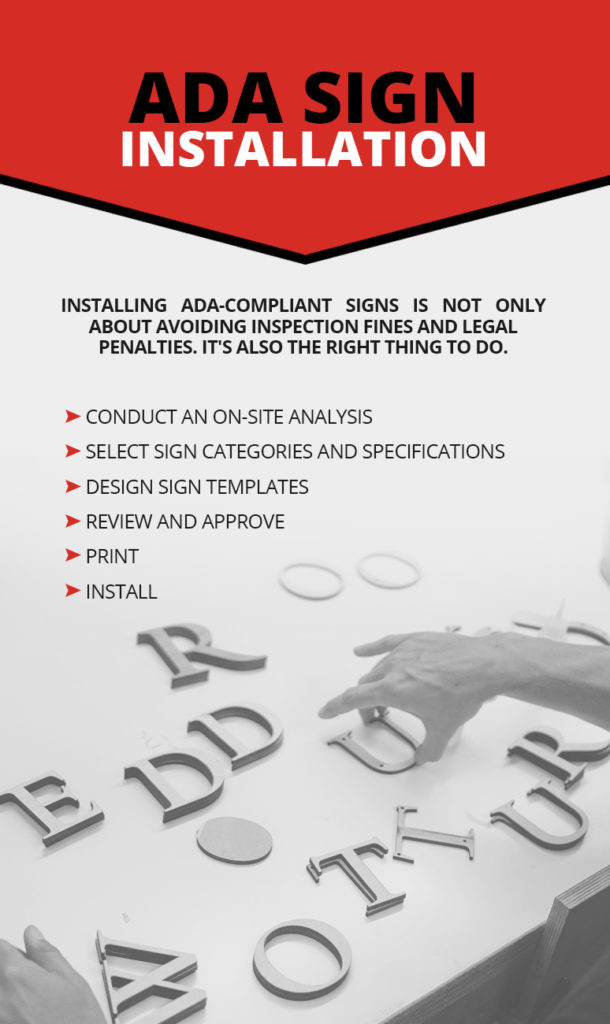Are your business’ signs ADA-compliant? What are the full requirements for proper ADA signage and graphics — and do you work in an industry with unique standards?
SpeedPro produces ADA-compliant wall, ceiling and mounted signage — including custom Braille signs and regulation wayfinding graphics — for clients spanning all industries. Ensure your building is both up to code and inclusive by partnering with our network of ADA-fluent printing pros.
What Is ADA Signage?
The Americans with Disabilities Act outlines federal laws prohibiting discrimination against or unfair treatment of individuals based on disability. The legislation provides equal opportunity protections for employment, transportation, education, accessibility and other civil rights matters. The ADA guidelines also govern public facility and commercial building access accommodations, including compliant building and room signage.
ADA compliance requires signage for every permanent room, space or area in or around a building. The ADA outlines four categories of permanent building fixtures, and therefore four general sign categories:
- Identification signs: The most common ADA sign type, identification signs name a specific room or building zone. You’ll see signs that read ‘Restroom,” “Elevator,” or “Accounts Payable Department.”
- Informational signs: Informational signs give further context to a room or building feature. This category differs from identification signs in that these markings add or clarify information about the room without naming or identifying the room type itself. For example, the text may say, “Employees Only,” or “No Smoking.”
- Directional or wayfinding signs: Directional signs assist guests in navigating through your building. Organizations from offices to hotels, sports arenas to schools, and municipal buildings to movie theaters will contain wayfinding signage to help traffic flow and designate building layouts for new guests. These signs usually display an arrow and language like “Faculty Offices Here” or “Restrooms This Way.”
- Overhead signs: As the name suggests, overhead signs are a particular class of ADA-regulated signage that hang from ceilings or are vertically mounted on walls at a minimum of 80 inches above the floor. This height provides enough clearance for a person with limited vision to move around safely. These signs often contain informational and directional text.
Locations for ADA Signs
Federal ADA guidelines and many state and local laws require ADA-compliant signs to identify many areas or objects throughout a building, including:
- Emergency exits
- Exits and entryways
- Elevators
- Restrooms
- Accessible parking
- Passenger loading zones
- Loading docks
- Public telephones
- Fitting rooms
- Automated teller machines (ATMs)
- Waiting rooms
- Alarms
- Industrial tools
- Operational machinery
- Equipment and facility controls
ADA Signage Requirements
ADA-compliant signs and graphics must adhere to the following design specifications:
1. Size
Compliant business signs have both mounting height and maximum viewing distance requirements. According to the ADA, most mounting heights should be no lower than 40 inches from the ground and no higher than 120 inches. Viewing distances are calculated in feet and should use logical estimates given a room’s layout, entryways, exits and lines of sight.
While the ADA doesn’t maintain set sign dimensions, it does have sizing guidelines related to each of the four sign categories.
- Sign width: A sign’s width is determined by the number of characters — individual letters, numbers and punctuation marks — and spaces between characters per line on the sign. The size of each letter and individual space will also play a role in the overall sign width. For example, 14 characters at a font size of 5/8 an inch will need a 10-inch wide sign.
- Sign height: The height of an ADA-compliant sign depends on its total number of lines and the size of the characters on each line. At a 5/8-inch font size, you need at least 2 inches of height per line, including the Braille translation.
2. Mounting and Placement
ADA-compliant signs can be installed in three configurations — wall-mounted, wall-protruding and overhead.
- Wall-mounted signs: Wall-mounted identification signs must be placed on the door’s latch side, between 40 to 60 inches off the ground. There should be 18 by 18 inches of open, clear floor space surrounding the placed sign. If double doors are present, signs should be installed to the right side of the right-side door.
- Wall-protruding signs: Signs protruding from walls must be a minimum of 27 inches off the floor and stick out a maximum of four inches. Protruding signs should not block doors, sprinklers or emergency equipment.
- Overhead signs: The bottom of an overhead sign must hang at least 80 inches from the floor and be held by stable, secure means. Like protruding signs, they must not block doors, sprinklers or emergency equipment.
Regardless of type, a sign’s final placement should be a minimum of 40 inches from the ground and a maximum of 10 feet from the ground to support reasonable reading vantages.
3. Text
Depending on the sign category, individual characters are typically 5/8 of an inch to 2 inches in size, printed in all uppercase lettering. The ADA also requires all permanent identification signs to contain both visual and tactile elements, meaning one visibly legible set of text and the other understood through touch, namely Braille. Here are the ADA sign requirements for each category of text:
- Visual text: Visual text encompasses the standard English characters printed in raised text. The raised text should protrude 1/32 an inch or 0.8 millimeters from the sign’s background, written in all uppercase if it’s an identification sign. Informational, wayfinding and overhead signs can be sentence-case.
- Tactile text: Tactile text most commonly refers to Braille lettering located directly beneath a sign’s visual lines of text, translating the visual text into tactile lettering. Braille needs at least 3/8 of an inch of spacing on all sides of the lettering. Directional or overhead signs may be visual-only, meaning no tactile text is needed.
The ADA regulates which fonts are appropriate for a sign’s standard printed characters. Sans serif and simple serif-style fonts are standard. Some fonts that meet ADA requirements include:
- Helvetica
- Futura
- Avante Garde
- Franklin Gothic
- Trebuchet
- Optima
- Eras
A sign’s raised-print text should not contain excess bolding, obliques, italicizations or any other form of font embellishment.
4. Colors
The ADA recommends signs be “high contrast.” It does not have rules or regulations on what color signs must be. Instead, it endorses the common-sense design benchmark that sign text and sign background colors should have at least a 70% color contrast ratio. In other words, dark text should be on light backgrounds, and dark backgrounds should display light text.
5. Graphics
ADA sign graphics are called pictograms. Many common accessibility signs contain near-universally recognizable pictograms with simple, centralized symbols signifying their message. A well-known example is the “no smoking” pictogram — a cigarette with an overlayed circle and diagonal line. Of the four sign categories, only identification signage has regulations pertaining to scale, spacing and pictogram placement. A sign with a pictogram included requires a 6-inch high area dedicated solely to the graphic. Although the symbol itself doesn’t have a sizing requirement, a good rule of thumb for visibility is around 4 inches.
Note: SpeedPro staff members are available to consult and create your sign’s complete, compliant design. The ADA’s complete list of sign regulations can be technical and — truthfully — rather confusing. Reach out so we can help.
ADA Signage and Graphics by Industry
Certain industries have stricter signage requirements than others. While ADA sign guidelines apply to all businesses and sectors, a few face additional design standards, given their services and facilities.
1. ADA Signage Requirements for Hospitals
Hospitals must have accessible parking spaces, van-accessible parking, properly sloped ramps and wheelchair-accessible traveling routes within and across facilities. In addition, hospitals also maintain some of the most varied sign and display types, including for these locations:
- Waiting rooms
- Common rooms (public and employee-only)
- Numbered patient rooms
- Wayfinding signage
- Restrooms
- Authorized personnel-only markers
- No smoking and no cell phone signs
- Emergency equipment signs
- Life safety signs (like emergency exits)
- Hand washing/sanitation signage
- HIPAA reminders
- Oxygen-in-use signs
- Message display centers
- Reserved accessible parking spaces
2. ADA Signage Requirements for Restaurants
Restaurants, bars and cafeterias already maintain federal and state safety and sanitation standards. ADA-complaint signage for the food industry ensures that these sanitation protocols are upheld. It also ensures accessible entryways at the ground level or ramp and accessible parking spaces with signage designating them.
Restaurants must outfit their interiors and exteriors with signs for:
- Primary entryways and exits
- Emergency exits
- Restrooms
- Reserved accessible parking spaces
- No smoking signs or smoking-designated areas
- Authorized personnel only
- Hand washing/sanitation signage
- Max restaurant capacity
3. ADA Signage Requirements for Grocery Stores
Grocery stores must also provide means for ease of access for people with disabilities. Given the narrow aisles, lanes and frequent redirection required during travel within a store, grocers must create and display fully compliant ADA signage clarifying directions and reducing mobility and visibility burdens. The grocery-specific ADA guidelines include rules for:
- Compliantly sized and secured overhead aisle signs
- Designated accessible parking spaces
- Primary entryways and exits
- Emergency exits
- Emergency equipment signs
- Alarms
- Restrooms
- Employee-only areas (like stockrooms)
- High-contrast display signs at service counters, including bakeries, butchers and delis
- Telephones and ATMs
- Loading or delivery docks
4. ADA Signage for Manufacturing
Warehouses, factories and similar industrial environments require high-visibility, clear and concise messages marking various work zones and operating vehicle routes. The safety of workers on the floor depends on it, as does a manufacturer’s reputation.
ADA signage most relevant to the manufacturing sector include:
- Inbound and outbound delivery docks
- Personal protective equipment (PPE) storage and apparel reminders
- Transportation equipment and vehicle speed limits
- Signs adjacent to operational machinery, tools, equipment and facility controls
- Hazardous materials warnings
- Emergency equipment
- Emergency exits
- Alarm systems
- No smoking or designated smoking areas
- Employee common rooms
- Warehouse offices
- Elevators or lifts
- Locker rooms
- Employee restrooms
5. ADA Signage for Retailers and Commercial Buildings – Civic and Mercantile
A business outfitted with compliant ADA signage signals their commitment to inclusivity and attention to detail. The majority of commercial buildings should contain some, if not all, of the following compliant signs:
- Numbered offices
- Numbered conference rooms
- Designated accessible parking
- Passenger loading zones
- Inbound and outbound shipment docks
- Restrooms
- Fitting rooms
- Sitting or waiting rooms
- Emergency equipment
- Emergency exit signs
- Alarm systems
- Elevators and lifts
- Employee-only areas
- No smoking signs
- Telephones
- ATMs
- Directional signage
- Break rooms
ADA-Compliant Custom Braille Signs
Braille characters are mandatory on all identification signs and highly encouraged on informational and wayfinding signage.
SpeedPro can assist in printed ADA-compliant custom Braille signs for your building’s interiors and exteriors. We’ll make sure all ADA sign tactile text requirements are met, including:
- Braille cells: Each Braille character is known as a cell, with individual cells comprised of tiny textured dots. Dots are dome-shaped — never square, pointed or plateaued — and come uniformly sized, 0.06 of an inch wide at the base and 1/4 of an inch high.
- Braille case: Lines of Braille should be written in sentence-case following contracted Grade II Braille shorthand when possible. Use uppercase Braille letters when part of a room number, initials or acronyms. Grade II Braille contains 265 single characters that represent common words or groups of letters. Braille translation software can ensure grammatically correct Grade II shorthand for ADA-compliance.
- Cell and dot spacing: Each individual dot should get 0.1 inches of space around its diameter. Space individual Braille cells 0.3 inches away from each other.
- Braille positioning: The lowest line of Braille on a sign should be located no less than 4 feet off the ground and no higher than 5 feet from the ground for reachability
ADA Sign Installation
Installing ADA-compliant signs is not only about avoiding inspection fines and legal penalties. It’s also the right thing to do.
SpeedPro’s nationwide network of studios can help make the right thing to do also the easiest thing to do. Clients ordering custom ADA signage and graphics undergo a step-by-step design process ensuring their signs meet all requirements — from ideation to installation.
1. Conduct an On-Site Analysis
On-site analyses will measure available wall space, nearby door radius, floor-to-ceiling heights and overall room dimensions. These measurements will provide the base for your mounting options. You’ll need to ensure that the ideal spot for your sign is noticeable and unobstructed at all times.
Some full-service printing studios — like SpeedPro — can perform an on-site analysis for you, providing a complete range of measurements necessary to outfit a correctly sized and spaced sign.
2. Select Sign Categories and Specifications
As noted earlier, the ADA recognizes four general categories of signage. Each maintains its own size, character, height, clarity and mounting requirements, among other general visibility and clarity obligations.
SpeedPro can help you pick the proper sign category for your application and walk you through that type’s detail level and any additional considerations.
3. Design Sign Templates
Full-service printing studios have the technology and equipment in place to create drafts of your final ADA signs. Base media, inks and finishes are high-quality, durable and follow the Americans with Disabilities Act and ADA Accessibility Guidelines (ADAAG). Raised lettering and Braille can also be added in-house, without the need for a second print or extra equipment.
We can also add customizations to your ADA signs while remaining compliant. Signs can feature:
- Company or business logos
- Corporate or brand-matching color schemes
- Corporate typeface – it’s sans serif and meets the required width-to-height and stroke-to-height ratios.
- Pictogram-compliant images or graphics
4. Review and Approve
Ensure sign fonts, colors, sizes, scales, pictograms and finishes are to your liking. Then, we’ll double-check final proofs against local and federal government signage standards in your industry one last time.
5. Print
SpeedPro can print ADA-compliant signs on many base materials, known as media. Pick from media like:
- Acrylic: A common sign base easily fabricated to include compliant Braille characters
- Calendered vinyl: Good for general purpose identification and informational signage
- Cast vinyl: An ultra-durable, configurable media to weather outdoor applications or within industrial settings
The ADA requires all accessibility-related signs and graphics to contain non-gloss finishes. SpeedPro studios provide anti-graffiti, matte and satin laminates that adhere to this regulation, ensuring signage compliance is maintained down to the “finishing” details — literally.
6. Install
With your new sign in hand, you’re ready to go. The only thing left to do is mount it. ADA sign requirements include rules for installation heights, so tactile signs are easy to reach, visual text is readable at a distance and all installations facilitate accessibility and safe movement.
First, clear the installation wall or ceiling area, removing clutter and other visual obstructions. Check that there’s adequate lighting to illuminate your sign. Review any nearby opening doors to make sure their radiuses don’t impede sign visibility. Verify that the floor space directly beneath the sign is smooth and level. All these processes are ADA recommendations.
Remember:
- Signs near doors should be installed latch side.
- Signs near double doors should be installed on the right-hand side of the right door.
- Signs should be wall-mounted between 40 to 60 inches off the ground. Hanging signs should begin at least 80 inches off the floor.
- Signs should have 18-by-18 square inches of open floor space surrounding their base.
Order ADA-Compliant Signs and Graphics
Contact your local SpeedPro studio to simplify ADA signage and graphics compliance — and support a truly inclusive environment at your place of business.

















